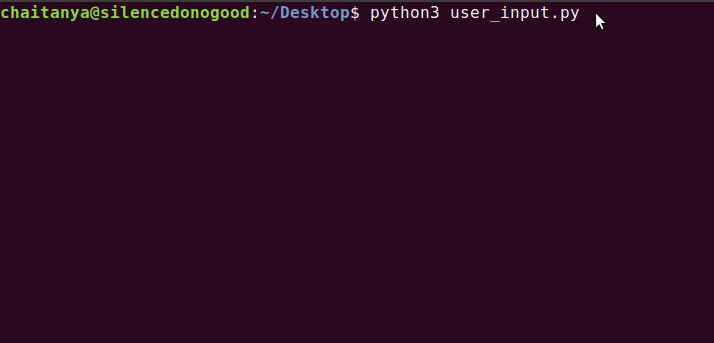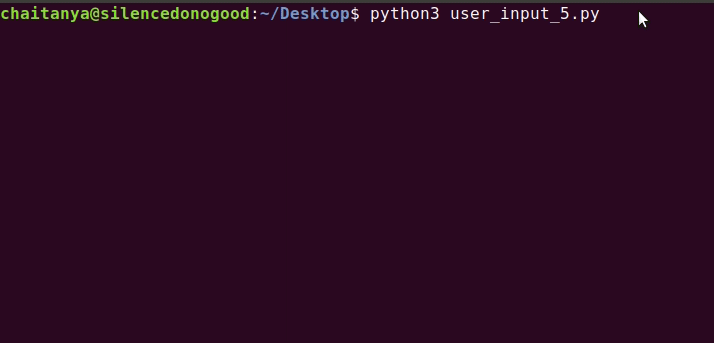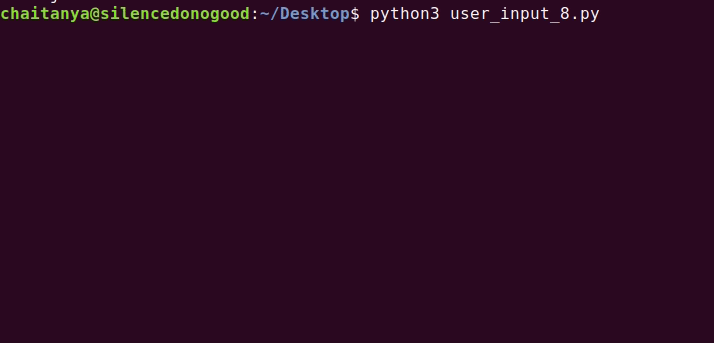Prograam That Reads a String From Input Until Recieves Zero
Python Beginner
A Complete Guide to User Input in Python
Learning near the Python input function in detail along with its many apply-cases
![]()
User input is critical for building interactive programs. Every programming language has its unique implementation of an input interface. C++ has scanf, Coffee has the Scanner class, and Blood-red has gets.
While in nearly cases, this input stems from the keyboard, other forms like mouse clicks, rails-pad, sensors, etc. are also possible.
As e'er, Python provides a simple framework for getting user input in the course of the input() function.
The input office reads a line from the console, converts information technology into a string, and returns it.
In this tutorial, nosotros will cove r the input() function in item using a diverseness of use-cases. We will talk over the several forms in which input can be and how to parse this input into our required format with the aid of code snippets.
Syntax
input([prompt])
Here,
prompt: an optional string argument, used to brandish a message for the user. Case: 'Enter Proper noun:'
When the input() function is chosen, the program flow halts until the user enters some input. The user then adds some information and presses the Enter primal. The input office returns to the program with the entered string.
entered_value = input('Enter some value: ')
print(entered_value) Output:

Input Type
The input function converts all data that it receives into the string format. Permit u.s. accept a look:
Output:
Enter name: Chaitanya Baweja
Enter age: 20
data_type of proper name: <course 'str'>
data_type of age: <class 'str'> We used the type function to check the object's data blazon. Equally you can see to a higher place, it does not matter whether we enter a number or a character string. Both of them return as cord objects.
Take an integer input from the user
As input() office returns everything as a string, we demand to perform some explicit type-conversion for accepting integers. Here, we volition apply the int() function.
Output:
Enter first num: x
Enter second num: v
Type of num_1: <class 'int'>
Type of num_2: <class 'int'>
The sum of given numbers is : xv
int(string)converts the given cord to an integer type.
Accept a bladder input from the user
Similarly, nosotros tin can get a bladder value using the bladder() office.
Output:
Enter value: five.6
Type of float_1: <form 'float'>
Twice the given numbers is : xi.ii User Input Exception Handling
A common result with type-conversion is the ValueError exception.
When the user enters input that cannot be converted into the given blazon, we get a ValueError exception.
For example, the user enters a random string for age.
num = int(input('Enter age: ')) Hither, the int() function expects an integer value wrapped inside a string. Any other type of value will result in an error. Look what happens when we enter 'nope' as input.
Output:
Enter age: nope ---------------------------------------------------------
ValueError Traceback (virtually recent call concluding)
<ipython-input-x-1fa1cb611d10> in <module>
----> 1 num_1 = int(input('Enter age: '))ValueError: invalid literal for int() with base of operations x: 'nope'
To ensure that the user enters valid information, we need to handle many such errors that unremarkably occur with user input. We will apply Python Exception Handling for this purpose. Take a look:
Again if we enter 'nope' as input:
Enter a number: nope
This is not a number. In the higher up snippet, if the user enters a not-integer input, the lawmaking will raise an exception. This exception is caught by the except argument where we print: 'This is not a number'.
Because of this try-except cake, our program will not crash on wrong user input.
Nosotros can utilize the exception block along with a loop. Thus, the user will be prompted once more and over again until they provide valid input.

Multiple input values in a single line
We can as well enquire for multiple values directly on a unmarried line with only one call to the input() role. For example, let'due south get some information near a student from the user and shop it in unlike variables.
Output:
Enter pupil's name, age and score separated by space:Chaitanya 20 100
Student Name: Chaitanya
Student Historic period: 20
Student Score: 100 Hither, nosotros separated the input string by spaces using the split() method.
Go a list of numbers as input
Simply what happens when you are non aware of the number of input values?
Let united states suppose that y'all need to enter a list of numbers and return their sum. Yous are not enlightened of the number of elements in that list.How practice we input this list?
We use both the divide and the map part. The dissever() method volition split the entered string into a list of strings. Then, the map() function will perform the int functioning on all the list elements.
Output:
Enter a list of numbers separated by space: x 20 30 forty 50 60
Intermediate_list: ['ten', '20', '30', 'twoscore', 'fifty', 'threescore']
Number List: [ten, 20, xxx, 40, l, sixty]
List sum: 210 In the code above:
-
input()returns a string containing numbers separated past spaces. -
carve up()returns a list of strings partitioned on the spaces. -
map()performsint()functioning on all the list elements and returns a map object. -
list()office converts the map object dorsum into a list.
Multi-Line input from a user
The input() function returns whenever it encounters a newline graphic symbol (when the user presses Enter key). Thus, if you lot try to ship multi-line information, input() volition only render the first line.
To overcome this, we can use for-loop. We get i line of input per iteration and stop when we receive an empty line ('Press Enter on an empty line'). Nosotros combine all these lines in a list.
Output:

Conclusion
Python provides a simple framework for getting user input. The input function reads a line from the panel, converts it into a string, and returns it.
The input office converts all information that it receives into the string format. We apply type-conversion to convert the input into the required format.
Exceptions occurring due to invalid input can exist managed using the endeavour-except block. The split and map functions help input multiple values in the same line.
Source: https://towardsdatascience.com/a-complete-guide-to-user-input-in-python-727561fc16e1
0 Response to "Prograam That Reads a String From Input Until Recieves Zero"
Post a Comment